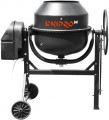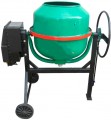Gear ring material
The material from which the
crown is made. It matters not so much in terms of the quality of concrete mixing, but in terms of the durability of the equipment.
—
Cast iron. The most common metal in the manufacture of the crown. Easily processed, quickly cast, characterized by minimal investment at all stages of production. Another notable feature of cast iron is its long service life. At the same time, under mechanical stress, the cast-iron crown can crack, and all kinds of abrasive particles crumble rubbing places. In operation, the crown of cast iron often rattles and vibrates.
—
Steel. High-strength crown material. Steel is more expensive than cast iron, which is more than offset by silent operation. Steel rim cement mixers are great for many hours of daily use.
—
Polyamide. The manufacturing technology of polyamide crowns is based on a synthetic composition endowed with elasticity and resistance to temperatures in a wide range. Rims made from this composite material are notable for their durability, lightweight design, smooth running and quiet operation. The polyamide crown can be partially changed — usually it consists of four parts and one worthless one can be easily replaced.
Drum/blade speed
The speed at which the drum or blades (depending on the type of mixing, see above) move during operation of the cement mixer. In most consumer-class models, this indicator is more of a general reference than practically significant — the optimal speed for solutions that such devices usually have to work with is about 23-28 rpm, and the vast majority of models fit well into this range. The differences between specific values, usually, are completely uncritical and are due to the difference in the size of the drums and the power of the engines.
Engine speed
The speed at which the cement mixer motor shaft rotates during normal operation.
Typically, the motor and drive are selected for each specific model in such a way as to ensure the optimal speed of rotation of the drum or blades (see above). Therefore, under normal conditions, this parameter has no practical significance, and it can only come in handy in the event of a breakdown of a standard engine — in order to choose the optimal option for its replacement.

